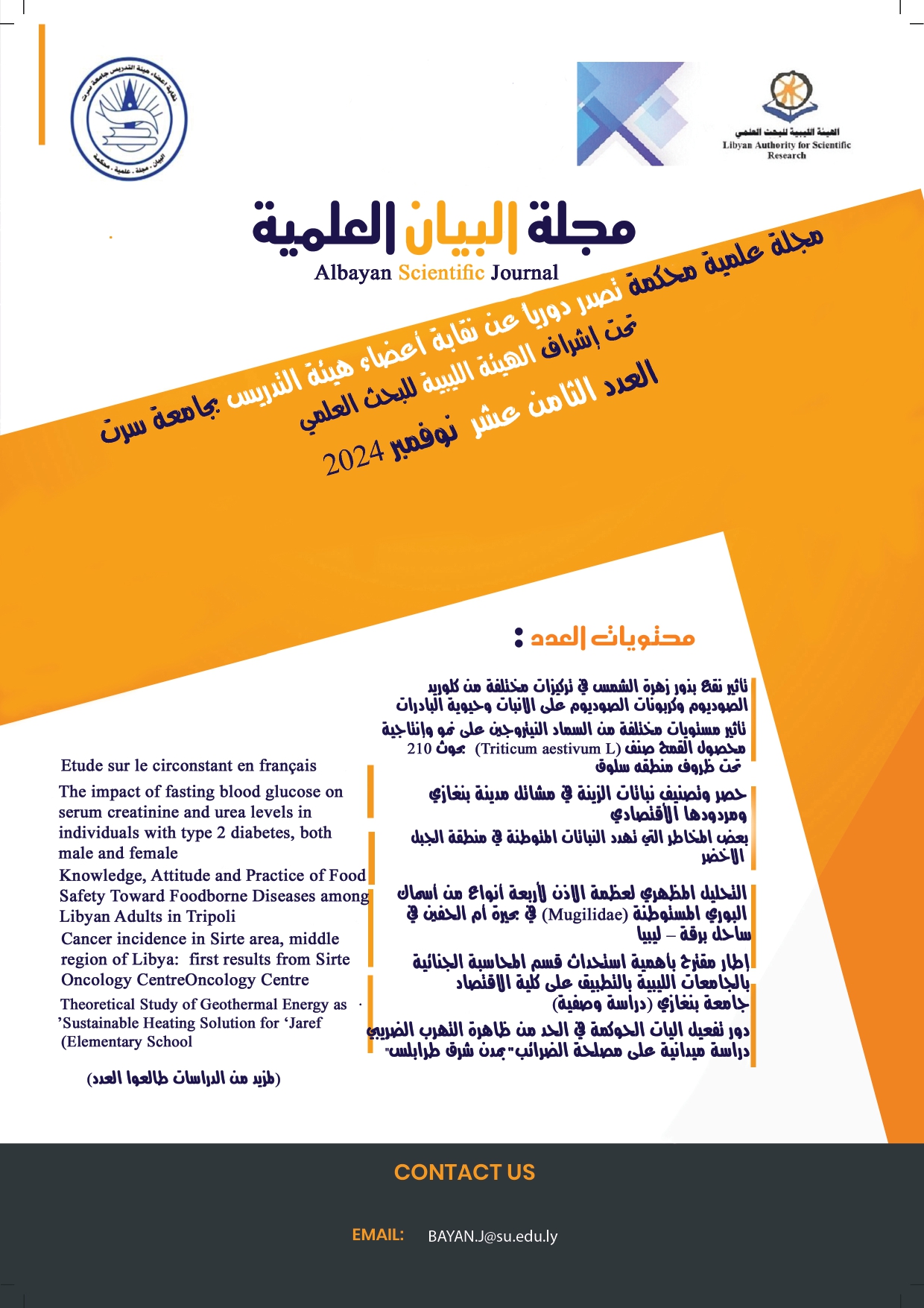التحليل المظهري لعظمة الاذن لأربعة أنواع من أسماك البوري المستوطنة (Mugilidae) في بحيرة أم الحفين، في ساحل برقة، ليبيا
الكلمات المفتاحية:
مورفولوجيا أوتوليث، القياسات الشكلية الهندسية، أنواع البوري، ساحل برقة، تحديد الأنواعالملخص
تناولت هذه الدراسة التباين الشكلي لحصيات الأذن (عظام الأذن) في أربعة أنواع من سمك البوري (Mugil cephalus، M. aurata، M. ramada، وM. capito) من ساحل برقة في ليبيا باستخدام التقنيات المورفومترية الهندسية. تم تحليل شكل Otolith باستخدام القياسات الشكلية الهندسية القائمة على المعالم، بما في ذلك تحليل المكون الرئيسي (PCA)، وتحليل الوظيفة التمييزية (DFA)، وتحليل الالتواء النسبي (RWA). أظهرت النتائج وجود اختلافات كبيرة في شكل حصوات الأذن بين الأنواع الأربعة، مما يشير إلى أن شكل حصوات الأذن يمكن أن يكون أداة موثوقة لتحديد الأنواع. كشفت PCA عن مجموعات متميزة تتوافق مع كل نوع، في حين سلطت DFA وRWA الضوء على السمات المورفولوجية المحددة التي ميزت الأنواع. تساهم هذه النتائج في فهم أفضل لتنوع أنواع البوري في المنطقة وتوفر أداة قيمة لإدارة مصايد الأسماك وجهود الحفاظ عليها.
المراجع
Adams, D.C., Rohlf, F.J., & Slice, D.E. (2004). Geometric morphometrics: ten years of progress following the ‘revolution’. Italian Journal of Zoology, 71(1): 5–16
Asmamaw, B., & Tessema, M. (2021). Morphometric Variations of Nile tilapia (Oreochromis niloticus)(Linnaeus, 1758)(Perciformes, Cichlidae) collected from three rift valley Lakes in Ethiopia. JAFH, 10, 341-355.
Bani, A., Poursaeid, S., & Tuset, V. M. (2013). Comparative morphology of the sagittal otolith in three species of south Caspian gobies. Journal of Fish Biology, 82(4), 1321-1332.
Bookstein, F. L. (1991). Morphometric tools for land-mark data. Geometry and biology. Cambridge Univ.Press, New York.
Brusatte, S.L., Butler, R.J., Prieto-Márquez, A., Norell, M.A., (2012). Dinosaur morphological diversity and the end-Cretaceous extinction. Nature Communications. http://dx.doi.org/10.1038/ncomms1815
Campana, S. E. (2004). Photographic atlas of fish otoliths of the Northwest Atlantic Ocean (No. 133). NRC Research press.
Chien, A., Kirby, R., & Sheen, S. S. (2018). One cryptic species of grey mullet (Mugil cephalus mitotype: NWP3) from Taiwan’s waters is worth cultivating for large roes using aquaculture. Aquaculture Research, 49(10), 3477-3481.
Cossu, P., Mura, L., Scarpa, F., Lai, T., Sanna, D., Azzena, I., ... & Casu, M. (2021). Genetic patterns in Mugil cephalus and implications for fisheries and aquaculture management. Scientific Reports, 11(1), 2887.
El-Zaeem, S. Y. (2011). Phenotype and genotype differentiation between flathead grey mullet [Mugil cephalus] and thinlip grey mullet. African Journal of Biotechnology, 10(46), 9485-9492.
Firidin, S., Eroglu, O., & Kutlu, I. (2017). Optimizing DNA extraction method for archived otoliths. Genetics of Aquatic Organisms, 1(2), 57-60.
Koeberle, A. L., Arismendi, I., Crittenden, W., Leer, D., & Noakes, D. L. (2020). Fluctuating asymmetry of adult Chinook Salmon (Oncorhynchus tshawytscha) otoliths from wild and hatchery origins. Aquatic Ecology, 54(1), 431-446.
Norman, M. L., Jonathan, K., & Kate, E. J. (2013). Geometric morphometric approaches to acoustic signal analysis in mammalian biology. Virtual Morphology and Evolutionary Morphometrics in the new millenium., 110.
Rohlf, F. J. (2003). Bias and error in estimates of mean shape in geometric morphometrics. Journal of Human Evolution, 44(6), 665-683.
Rohlf, F. (2008). tpsRelw, Relative Warps Analysis, version 1.46 (computer software). Department of Ecology and Evolution, State Univ. of New York at Stony Brook.
Rohlf, F. J. (2009). tpsDig version 2.14. Stony Brook: Department of Ecology and Evolution, State University of New York at Stony Brook.
Russo, T., Pulcini, D., O’Leary, Á., Cataudella, S., & Mariani, S. (2008). Relationship between body shape and trophic niche segregation in two closely related sympatric fishes. Journal of Fish Biology, 73(4), 809-828.
Ponton D. (2006). Is geometric morphometrics efficient for comparing otolith shape of different fish species? J. Morphol., 267(6): 7507
Sadighzadeh, Z., Tuset, V. M., Valinassab, T., Dadpour, M. R., & Lombarte, A. (2012). Comparison of different otolith shape descriptors and morphometrics for the identification of closely related species of Lutjanus spp. from the Persian Gulf. Marine Biology Research, 8(9), 802-814.
Tuset V.M., Lombarte A., Assis C.A. (2008). Otolith atlas for the western Mediterranean, north and central eastern Atlantic. Sci. Mar., 72(S1): 7-198.
Zelditch, M. L., Swiderski, D. L., & Sheets, H. D. (2012). Geometric morphometrics for biologists: A primer (Second Edition). Elsevier Academic Press.
Więcaszek, B., Nowosielski, A., Dąbrowski, J., Górecka, K., Keszka, S., & Strzelczak, A. (2020). Fish size effect on sagittal otolith outer shape variability in round goby Neogobius melanostomus (Pallas 1814). Journal of Fish Biology, 97(5), 1520-1541.













